By
Cognitive Dissonance
Updated on Saturday, November 15th, 2014
Did you know the explosive force of one gallon of gasoline is equivalent to several sticks of dynamite? While it is admittedly difficult to create that explosion without rapidly spraying the fuel into the air before igniting it (for example Hollywood special effects) gasoline does burn vigorously once ignited and it is an extremely aggressive accelerant for nearly any combustible object it touches. In short gasoline is an extremely dangerous liquid and should not be treated casually.
If you are a homeowner most likely you have a few gallons of gasoline hanging around in the garage (or some other outhouse) for use in your lawn mower, tiller, string trimmer or generator. In fact you might have more than ‘just’ a few gallons on hand. Based upon what I see now and then while filling up at gas stations, people tend to keep one or more five gallon container of fuel on hand at all times.
While safe gasoline storage and handling has always been on my mind since I had a lengthy conversation many years ago with a volunteer fireman about burning buildings with containers (as well as power equipment) full of gas, my concern reached the acute stage last year when Mrs. Cog and I moved into our new-to-us homestead up here on the mountain. Our cabin, plus the detached garage and a third outbuilding, are all constructed of logs. Needless to say we live and work in a more combustible environment than most and must always be mindful of fire safety.
Even without the added risk of storing gasoline on site Mrs. Cog and I, as well as everyone else who lives in a rural community with a volunteer fire department, must soberly accept the fact that in the event of a fire “We the Residents” are the first responders and cannot expect professional firefighting assistance for anywhere from thirty to sixty minutes or more. Several times over the last year I have read in the local newspaper the following phrase. “When the fire department arrived the structure was fully engulfed.” This means we must carefully assess not only our fire fighting capacity, but heightened fire risks. One of the most obvious, and easiest to mitigate, is the storage and handling of gasoline.
For the last year I have been storing several five gallon containers of gasoline in an outbuilding and, while nervous about it, I put off doing anything to remedy the situation because other projects appeared to be more pressing. But when for a variety of reasons we decided to increase the amount of gas on hand to eight or more five gallon containers, it was time to come up with a workable and safe(r) solution to our gasoline storage problem.
We could have purchased (or built) an additional small storage building and located it away from the rest of the buildings. But I wanted to keep expenses down and didn’t wish to build something permanent because I might want to move it at a future date as we clear additional trees from around the buildings. Plus buildings large or small tend to accumulate tools and other equipment (‘stuff’ is the proper term) and I wanted to create a dedicated storage area used only for gasoline and other flammable liquids such as paint thinner etc.
I briefly considered both above and below ground storage tanks, but quickly discarded the idea because of expense, permanency and the need to acquire secondary equipment/storage to transport the gasoline from the gas station to the storage tank. I wanted flexibility and ease of use as well as low expense. I wasn’t trying to fuel a fleet of trucks or farm equipment, but simply to store enough fuel to serve my needs for 12 months of ‘normal’ operations on the homestead. This meant 40-50 gallons of gas in relatively small containers that can be easily refilled and older fuel rotated. From my point of view the less I handled the gas the better off I am.
What I needed was a non flammable container that was light, relatively weather tight, low to the ground with a wide opening as well as sturdy, lockable and movable if needed. I was stumped for weeks and rather than rush a solution I let the problem percolate in the back of my mind while I attended to other tasks. Then one morning it came to me; the solution was a large plastic storage box. A quick Internet search narrowed the selection to something called a “deck box”, basically a long low plastic box (4’ to 5’ wide x 2’ deep x 2’ tall) that opens at the top and is placed on pool decks to store seat cushions, pool supplies etc.
Some further research indicated there was a wide selection available for purchase, but that quality varies greatly between manufactures and the products they produce. The storage box is to be placed on the side of an old logging road about 80 feet from the garage, so there is always the danger it might be hit or side swiped by a passing vehicle, rare as that might be. Low and moveable shines in this case. I would rather have to deal with moving it back than rebuilding and gasoline saturated ground from spilled containers.
In my case the container was placed under a tree that will provide cooling shade in the summer. This meant the box needed to withstand a small to medium sized limb falling on it. Plus it needed to be big enough inside to hold eight five gallon containers of fuel side by side with some room to spare. After much research and study, including expanding my budget by a few dollars to accommodate my final choice, I finally settled upon the Lifetime Extra Large Deck Box.
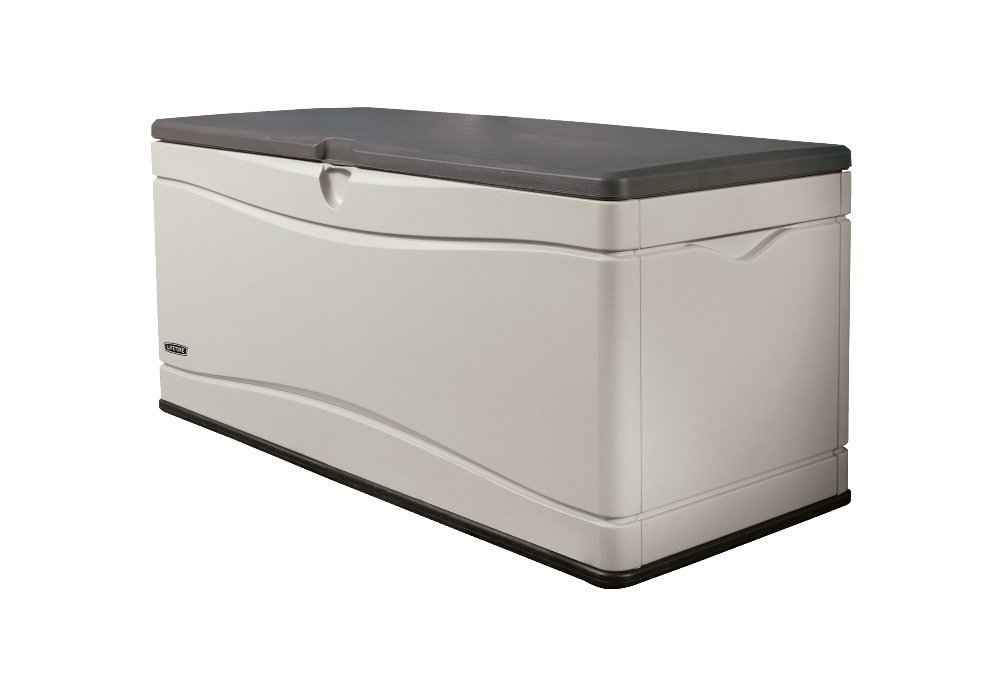 While it was not the cheapest it was well reviewed, was sturdier that other similarly priced boxes because it was constructed with a double wall system and was lockable with a stout top that utilized a quality hinge/spring system. This allowed the top to open wider than 90 degrees so it remained open, and springs to prevent it from slamming shut when my hands were full handling the fuel containers.
While it was not the cheapest it was well reviewed, was sturdier that other similarly priced boxes because it was constructed with a double wall system and was lockable with a stout top that utilized a quality hinge/spring system. This allowed the top to open wider than 90 degrees so it remained open, and springs to prevent it from slamming shut when my hands were full handling the fuel containers.
Since I intended to increase my fuel storage capacity I also needed to purchase additional five gallon containers. Needless to say I was shocked by how expensive they were. One could easily drop $30 or more on one five gallon container at the local hardware or supply store. However I found four Midwest brand five gallon gas containers for under $70 on Amazon with free shipping if you are a Prime member. This brought the unit price down to around $17 plus tax, a very reasonable price.
Regardless of the brand or size you ultimately acquire, ignore the temptation to use anything other than the red approved gasoline ‘cans’. That same conversation with the fireman informed me of how many homeowner accidents were caused by idiots putting fuel in unlabeled containers (including large glass bottles) and then either they, or someone else, didn’t realized there was gasoline in it and disaster followed.
Anyone who has not purchased a fuel container in the last five years will be shocked with the Rube Goldberg contraptions that pass for spouts these days. Once again California leads the nation in regulatory standards (CARB) and these new ‘no spill’ spouts are nearly unusable. I already own a few ‘Midwest’ cans as well as several by two other manufactures. Midwest does a decent job with the spout and the container itself is top quality. Whatever you do, make sure you understand the dimensions of your gas cans when filled before selecting the ‘deck box’ or other solution you come up with. After all, the fuel containers must be able to fit inside the storage box and after the fact is not the time to discover they don’t.
The only unknown I haven’t dealt with yet regarding using the deck box for gasoline storage is if fuel vapors will build up inside the box, particularly during the hotter days of summer. Since I installed mine during the cooler weather of the fall I have not crossed that bridge yet. I shall monitor the situation and if needed I can cut some vents into the sides of the box. While that might compromise to some degree my desire for water tightness I do not wish to create new problems with my ‘solution’.
I always make sure all spouts are tight and functioning properly and I replace those which are not. It is better to be safe than sorry. I can’t tell you how many times I have watched a person fill a container at the gas station and see rags, socks, paper towels and so on stuffed into the spout or the container itself to plug it. Talk about Molotov cocktails.
In addition, for safety reasons I do not store the one or two five gallon containers (nor the cans of gas/oil mix for the chainsaws and trimmers) I am actively using to fuel my equipment in the long term storage ‘deck box’. Those cans remain in my garage or other outbuilding. Since there is nearly always a little spillage during use (despite the ‘no spill’ spouts) I have no intention of putting a half empty can with spilled gas on the outside and around the spout back into the storage box.
Plenty of separation from the garage.
While I see a great deal of discussion on the Interwebby regarding the pros and cons of ‘stabilizing’ your fuel, I have had good luck using “Stabil” fuel stabilizer and always add it to all fuel purchased regardless of when I expect the fuel to be used. While it increases the overall cost of each gallon of gas you just don’t know when gas might sit for an extended period of time. So I simply assume it will go stale and stabilize all of it.
In addition, since I live in Virginia farm country several local gas stations in the area carry a premium blend that is 100% gasoline with no ethanol added. While purchasing premium fuel for lawn mowers and such may seem like overkill and a waste of money, I do not wish to use fuel cut with alcohol/ethanol and will pay a premium to avoid doing so. As well, since all the fuel in storage is premium I can use it in any car, truck or equipment without concern about grade or blend. The art of effective prepping is to give yourself flexibility and choice now as well as in the future. Considering how valuable fuel will be during a time of emergency or disaster, fifty or sixty cents extra per gallon for premium fuel and the stabilizer is well worth the expense in my book.
On a side note Mrs. Cog and I follow a practice up here on the mountain of maintaining at least half a tank of gas in each vehicle at all times. In essence we consider half full to be empty and always make sure we top off when we get close to half. Since we can get socked in by weather for days or even weeks at a time, keeping each motor vehicle gas tank at least half full might actually be a life or death decision at some point.
This also applies to the fuel tanks on your power equipment and especially your portable generator. In fact, if your generator gas tack is not full right now, then shame on you. The time to worry about having enough gas on hand is not when you absolutely need to use the generator. Considering an average 5000 watt generator under full load will go through eighteen gallons of fuel in 24 hours, it makes sense to start out with a full tank. This of course is just another reason to stabilize all your fuel since properly treated gasoline will not absorb water or gum up the carburetor on your power equipment if left over the winter.
More importantly if our long term fuel storage is used or otherwise compromised during bad weather, the fuel tanks in our vehicles can always be siphoned and utilized. Just make sure you have some way to siphon gas from your vehicle in an emergency. Small hand pumps with lengths of tubing can be purchased for less than $20 and in a pinch a long slender tube can be used to siphon just as long as you don’t mind getting some gas in your mouth. Yuck! Just make sure whatever you purchase or have on hand is designed to be used with gasoline/flammable fluids.
Nearly all of the ‘deck box’ units I researched were relatively simple to assemble, consisting of pieces of preformed plastic which snap together to create the bottom, sides and top of the box……though some accomplish this much better than others. Pay attention to customer feedback when doing your own research, but don’t be too swayed by negative comments unless the same issue(s) are consistently complained about by a variety of customers. Keep in mind that some people are not mechanically inclined and would have a problem with any assembly requirements.
Since I expect I might move the location of the storage box at some point in the future I wasn’t too concerned with base preparation. I suppose if I were locating it permanently I might consider a concrete pad or a more substantial gravel/stone base. But in this case my primary concern was an even base (though not necessarily ‘level’) so that the box would not twist when loaded and prevent the top from closing evenly and uniformly.
As you can see from the following photos I scraped off the loose leaves and dirt from the surface, then added a few bags of ‘paver base’ followed by three bags of ‘pea gravel’. After doing so I decided the slope was too great and a few heavy rains might wash some (or all) of the base away, prompting me to add three supporting sides to the base using some scrap wood I had hanging around. This included a piece of Locust log for one of the sides and some pressure treated stakes to hold the entire mess together. Whatever it takes.
On a side note, please don’t forget to rotate your gasoline stock. I pull containers from the right side and replace on the left. Based upon two summers experience here on the homestead I will go through all the gasoline every 12 months or so, another reason to stabilize the fuel before storing.
In addition while I do not normally use fuel stabilizer in our motor vehicles, we do own one small truck that is rarely used. Because of this I decided to add ‘Stabil” to the fuel the last time I filled it since it might just be six months or longer before we use the truck enough to warrant refilling the tank. I don’t wish to doubt the quality of any fuel I have on the homestead so once again the ‘Stabil’ fuel stabilizer is cheap insurance from my point of view.
The total dollar amount invested in the gasoline storage ‘deck box’ plus base materials was less than $200 plus the cost of the four new fuel containers I needed ($70) and the forty gallons of fuel ($140). Not including research time assembly was less than an hour while site preparation, filling the four new gas cans and moving all the gasoline to the new storage area amounted to less than 3 hours including travel time to the gas station. To be honest I have no idea if my solution has violated some obscure building code and I could care less. If the county has a problem with me moving a known fire hazard away from a combustible building they can inform me at the next community charity pancake social.
My solution for long term gasoline storage works for me, but it might not work for you and your unique circumstances. So please don’t take what I have to say as gospel or the last word on the subject. The important takeaway here is to get the majority of your fuel out of, and away from, buildings and equipment. Those five gallon containers of fuel you have stuffed away in the corner of your garage are not as harmless as they appear. Just because nothing has happened in the past doesn’t mean it won’t happen in the future. If you don’t believe me, just talk to a fireman and see what he or she has to say on the subject.
10-24-2014
Cognitive Dissonance
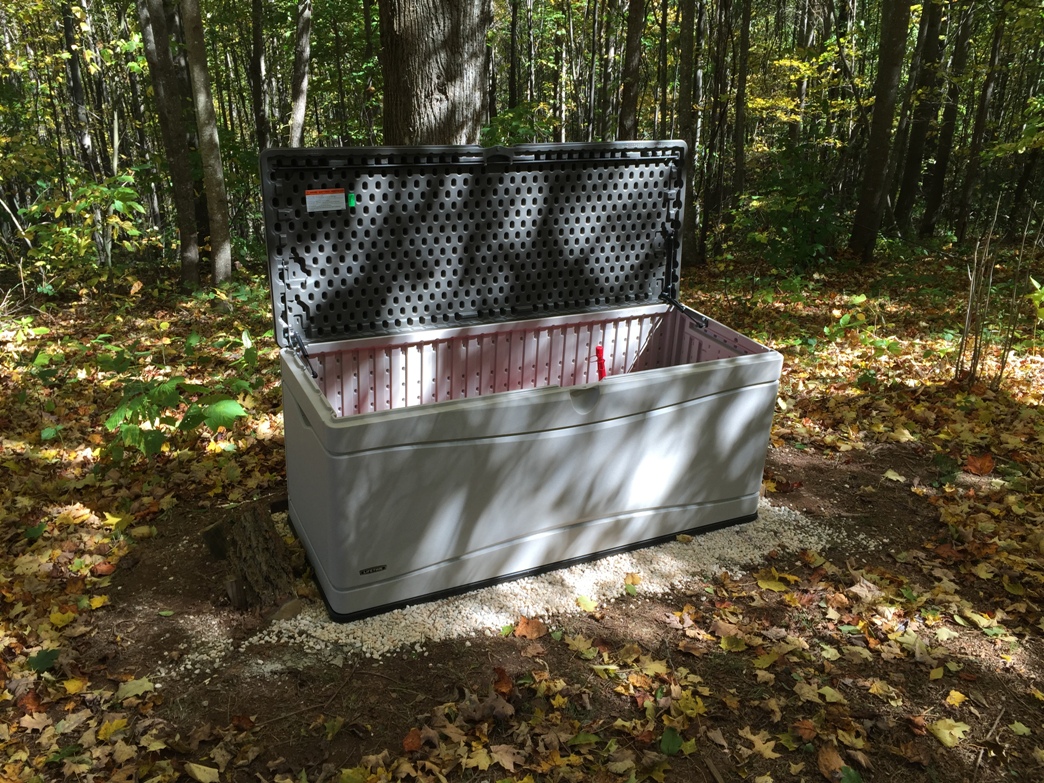 Completed on a pretty fall day.
Completed on a pretty fall day.
Updated on Saturday, November 15th, 2014
I ended this piece by explaining the only thing I had not dealt with was venting the storage box to dissipate any gasoline vapors that might accumulate. With the expectation that my daily monitoring of the box would convince me of the need to install proper vents, I was thus not surprised to find this was indeed the case.
Combined with several warnings from concerned readers both in the comment section below and via private email, there was never a doubt in my mind the vents would be installed.
My primary concern when installing the vents was to not compromise the structural integrity of the sides of the box. While they are double walled, each wall is only fused together at a few points. Therefor I did not wish to disturb those junctions.
On the outside of each end of the box are stylized recesses in the plastic that act as handles to help when carrying the box with another person. It is here that the double walls come together and the side is the thinnest so it was here I decided to cut openings on both sides, then cover it on the outside with a manufactured vent designed to keep water out while air circulating. The two images below show the final product.
Thank you for your comments, emails and concerns. Rest assured I had no intention of blowing myself up and I recognize the very real possibility of doing so if I had not vented the storage box. The vents were installed over a week ago and no gas fumes have been detected inside the box since them.
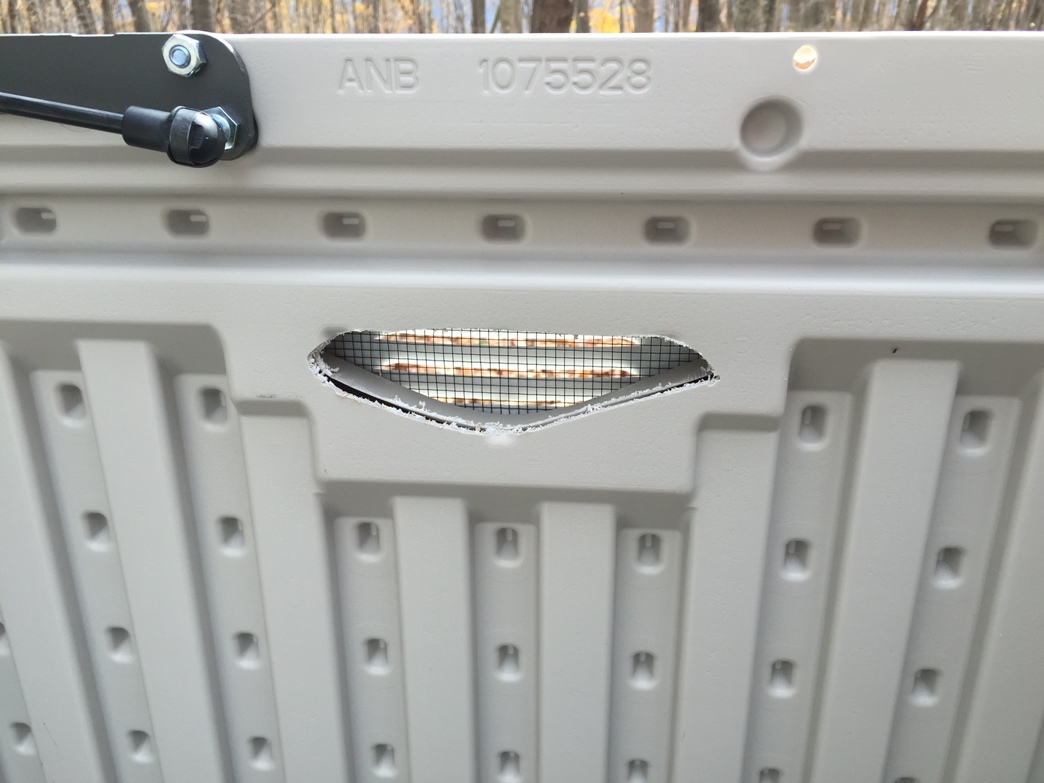 Cutout for the vent seen from inside.
Cutout for the vent seen from inside.
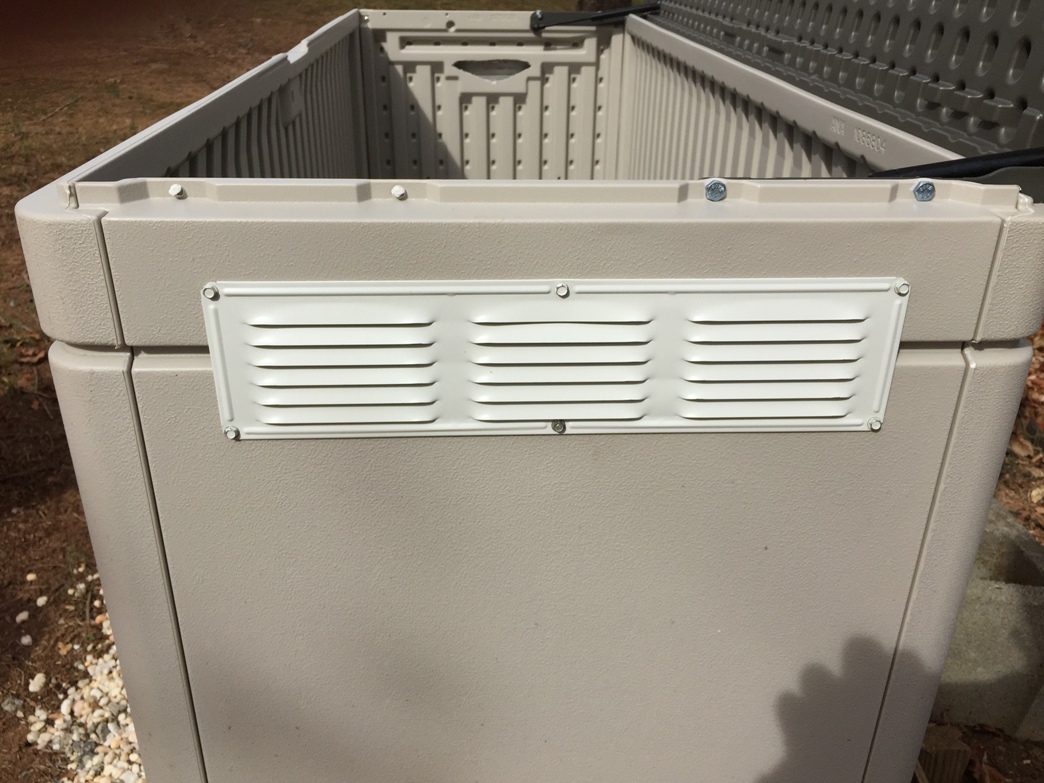 Outside vent installed with view over the top of the other inside cutout.
Outside vent installed with view over the top of the other inside cutout.


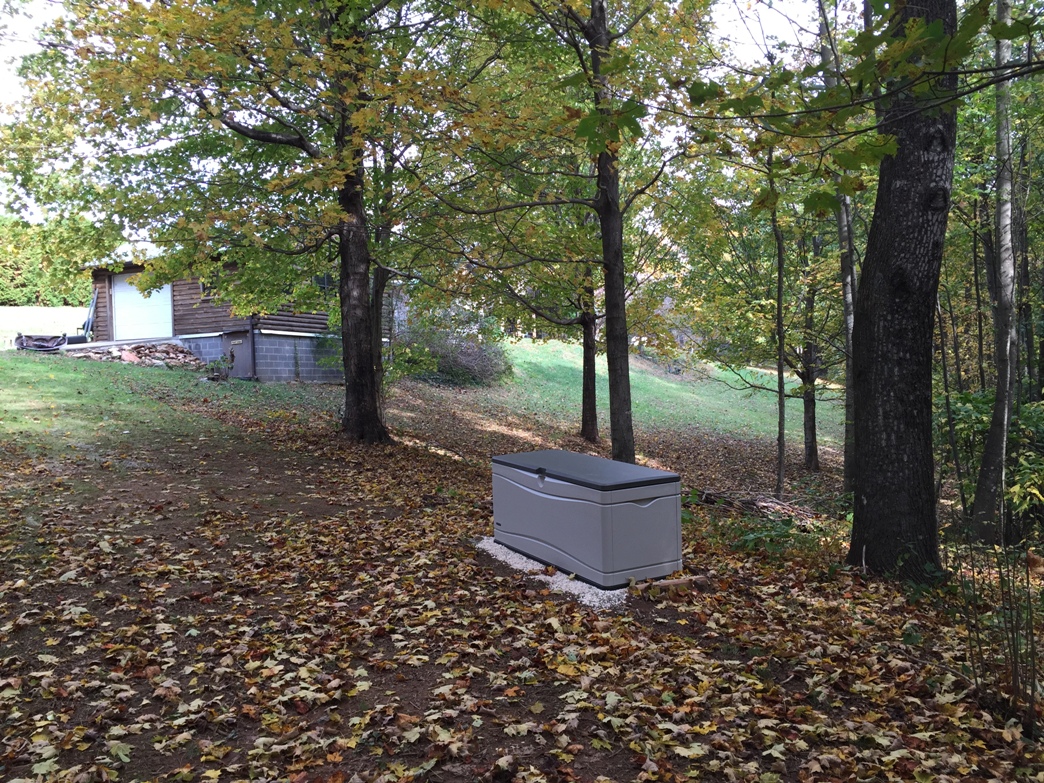
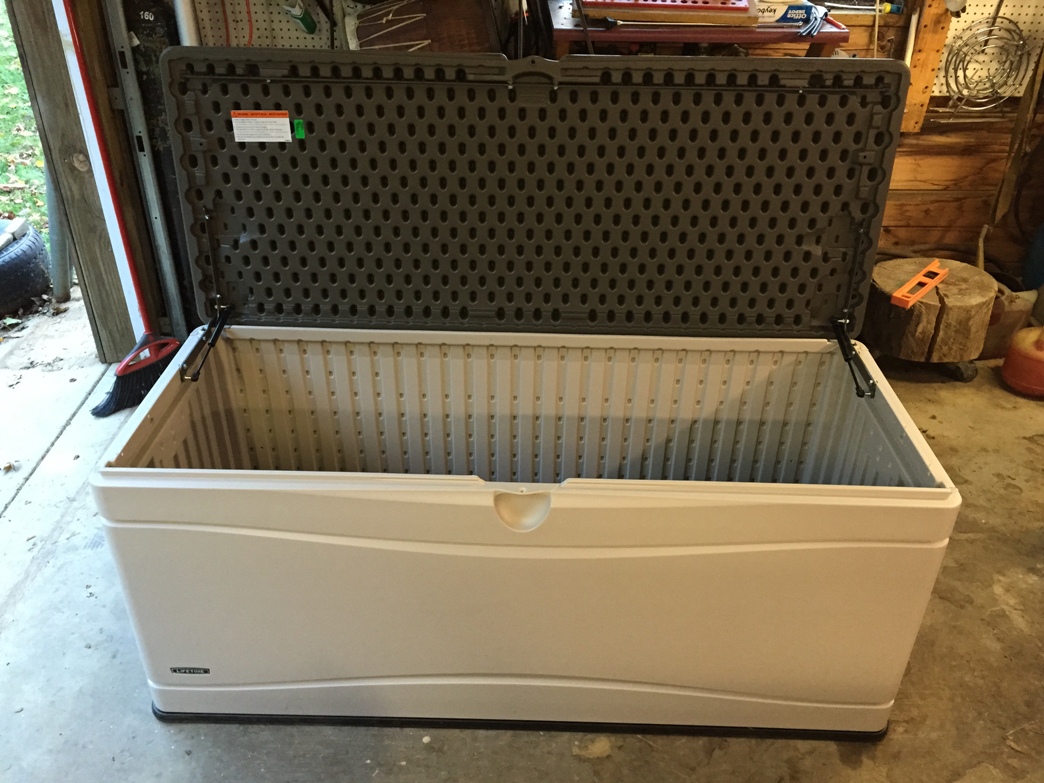

Mr Cog,
Great article and great timing as I need to do this also. I’ve been putting this off for a month now for the same reasons. I built this little shed 3x6x5 a few months ago, it was my first solo build and I think it came out pretty good. I’m going to move it to the corner of the property as far away from the house as I can.
I know you mentioned ventilation and I think that is ultra important. You could just drill some holes in it or get some cheap plastic vents.
Mr Pepper
Thanks to a reader, an engineer, who emailed us with some details about the above post. An excerpt from that correspondence:
I’d like to make you aware that your plastic gas storage box may have a deadly flaw. Plastic builds up static electricity which could ignite the gas vapor if enough vapor is present and there is a static spark. Seems unlikely, but there have been documented instances of vapor igniting in a truck bed with a plastic bedliner. This happens when someone fills up a gas can while it’s in a covered truck bed and then touches the plastic immediately after the fill up while the vapors are still lingering. So please tell Mr. Cog to go ahead and install some downward louvered vents in the sides near the top of the box to reduce the possibility of vapor build up. A downward louvered vent will not allow water/snow to easily enter the box. I can envision a scenario where someone quickly opens the lid of this box and then touches the box creating a spark that ignites the vapors. Again its unlikely, but a couple of side vents should be cheap insurance. My solution to this entire problem was to put a 50 gallon gas tank with a pump in the back of my full sized pickup. It’s a $1500.00 solution , but it solves my transportation, safety and legal issues for storing gas in the suburbs.
Yesterday evening Cog and I did make a supply run down the mountain and purchased vents with a screen mesh to install in the storage box as suggested here. Thank you to the party who contributed this. :-)